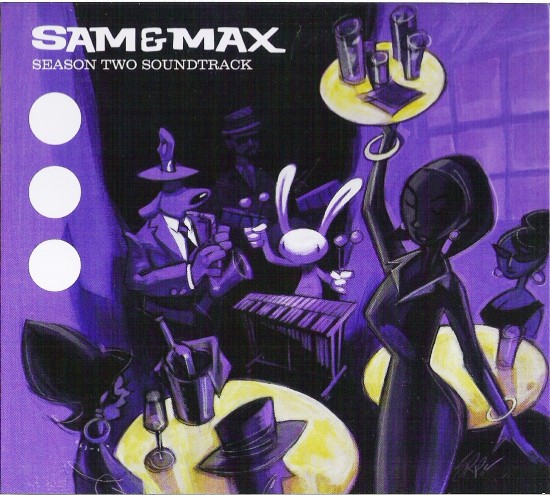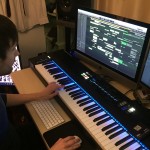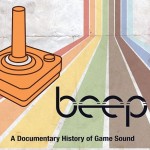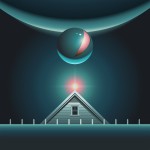Sam & Max Season 1 was one of my favorite soundtracks of 2007. For that reason, I was greatly looking forward to the Sam & Max Season 2 soundtrack, so I’ll say I’m a little embar-rassed that it slipped by me unnoticed in October of this year. No worries though, we’ve finally caught up and listened to the 2-disc soundtrack, and I have to say right out that you’re in for something different this time around.
For those of you out there who loved the Sam & Max Season 1 soundtrack, you’ll be pleased to know that composer Jared Emerson-Johnson doesn’t stray too far from his jazz roots. Even more, we have a special treat for Emerson-Johnson’s fans out there, as we’ve got in touch with him to provide us with exclusive liner notes for some of ours and his favorite tracks from the Sam & Max Season 2 soundtrack, similar to how we did with Hitoshi Saki-moto for Valkyria Chronicles last month.
Find out what OSV and Jared Emerson-Johnson have to say about this latest Sam & Max outing after the jump.
I’ll start by saying that while Season 2 stays true to the series’ jazz roots, there is a much wider variety, and a completely different ambiance than that featured in Season 1. Dark at-mospheres, Christmas themes, mariachi, a taste of techno, and even an homage to Punch Out!! are just a few of the things you’re going to hear.
You’ll notice there are fewer tracks as well, but they’re much longer. The two discs feature the official Season 2 soundtrack, but there’s an additional bonus contained on a data file on disc two featuring cutscene and trailer music along with some arrangements of Season 1 ma-terial. It all starts with the swanky yet downcast brass notes of “T.H.E.M.,” which pro-gresses with sparse percussion and deep brass and bass notes that are heavy with dissonance, immediately different from the bright and sunny Season 1. The seductive melody that sits on top is loud and clear, distancing itself from the rest of the mix. This is actually one of ours and Emerson-Johnson’s favorite tracks both, so I guess it’s good that it comes first!
Emerson-Johnson on “T.H.E.M.”:
I had wanted to write the piece that eventually became T.H.E.M. for awhile, even back during production for the first season. I had actually sketched it out long before produc-tion on season 2 even began. Moving from the first season to the second I really wanted to dig into the essential core of Sam & Max’s more earnest detective-y side—especially since the sillier, more ironic material is never in short supply. I was sure there would be at least one spot in the season where it could fit in, and after our first music design meet-ing, it was clear that it would sit nicely in the redesigned Bosco’s environment.The piece itself was written as a musical gift to Michael Whitwell and Jordan Wardlaw (the trumpeter and saxophonist who performed throughout both seasons). I wanted to create a simple, essential piece of music that would show off their artistry without any ornate composition “getting in their way.” For that reason, T.H.E.M. stays very simple and is highly improvisational. The bulk of the piece just sits on a single chord and mari-nates in the blues scale. That’s my favorite side of Sam & Max’s universe, actually. Dark, simple, and a little bit off-kilter. I feel like their wise-cracking stands out best when it’s set against something genuinely gritty or grim.
We started off the soundtrack for that very reason—especially since much of the music that follows moves pretty clearly through various other genres, following the twists and turns of the season’s stories. I wanted the tonal starting point to be simple and uncom-plicated by the specifics of the story that develops.
From here, it starts to look a lot like Christmas, but with a catch. “Arctic Hush” offers the familiar Christmas melody from “Carol of the Bells,” which I’ve always found to be a rather hectic and dark Christmas piece. The backing for the piece is just as dark and dissonant as the previous track. “Unholy Workshop,” on the other hands, features some jingle bells and a somewhat sweet melody with bells and woodwinds before a mischievous drum line comes in with an electronic edge. The swing and pauses between measures are a nice touch, adding a new dimension to “Carol of the Bells” once again. Overall, I’m impressed with these tracks, although the fact that we’re so close to Christmas right now probably helps.
Emerson-Johnson on “Arctic Hush” and “Unholy Workshop”:
There are a number of little Christmas carol quotations throughout the score to Ice Sta-tion Santa, but the Carol of the Bells is probably the most prominently featured. To me, this was a little bit of a no brainer, since that piece of music has always felt quite haunt-ing to me. Growing up, I was never entirely sure how it fit into the Christmas spirit; however, it’s easy to see how it fits into the Sam & Max universe’s warped North Pole. What a freaky tune.
From here, it’s on to the Punch Out!! reference that you were likely wondering about. The track is titled “TKO,” and the wailing guitars and synths along with rock percussion are care-ful to keep their distance from the original Punch Out!! melody, although the reference is both obvious and awesome. This track should be up on OverClocked ReMix. The guitar work is great, and the synths and percussion do a great job to give the piece an appropriate energy level.
Emerson-Johnson on “TKO”:
The original Punch Out!! game is definitely on my list of the top ten NES games from my childhood. The idea to reference the spirit of the music was Brendan Ferguson’s idea, and the whole sequence was very much his concept.Not surprisingly, since T.K.O. serves a very specific tonal purpose in the context of the boxing mini-game, it’s also the first large deviation from the jazzier roots of the music for the series. It was actually a lot of fun to do something so very different, and yet figure out little ways to make it fit into the overall Sam & Max sound palate. Bill Storkson’s guitar performance on that track is a huge part of why it works so well. He is a monster.
Right when you thought you were going to miss out on a quirky vocal track like those heard in Season 1, “The Friendly Demon Song” comes in. The musical backing is very show tune-like, with a big band feel, and the vocals, “He was a fearsome demon, he had a very scary form. He was the most unholy creature that was ever born. Even the other demons were scared to let him join their games, and if you want to meet him you just have to shout his name.” Yeah, that’s right, a play on “Rudolph the Red Nosed Reindeer.” Quirky enough for you?
Emerson-Johnson on “The Friendly Demon Song”:
The lyrics for that tune were written by Brendan Ferguson, if memory serves. Believe it or not, “Rudolph…” is still very much under copyright, so that’s the purpose of the me-lodic variation. Fortunately I’m a total geek for that kind of thing, so it was a fun little assignment. It’s always interesting to me when I’m tasked with finding a way to hit all of the right aural buttons to make people associate one tune with another, without ever di-rectly quoting anything from the original. As for the singer, I will just say that he is hands-down the easiest musician I’ve ever had the pleasure of working with; and, yes, he is the same destined-for-stardom vocalist from season one.
In another change of direction, “Beneath the Island of the Chimps” features wavering strings and distant, rumbling percussion before descending harp melodies and a choral pad and organ join in to create an unsettling and awesome atmosphere. I am thoroughly im-pressed. He follows this up with “Sturm Und Drang” which is a bit more lively with de-scending woodwind bits, ominous organ chords, and some trumpet melodies layered over top for good measure. Emerson-Johnson needs to release an entire CD of this kind of mu-sic!
Emerson-Johnson on “Beneath the Island of the Chimps”:
The music that accompanies the underwater Ocean Chimp colony is actually a second attempt at a track for that location. Before the environment was fully modeled I’d started writing a much more upbeat tune that focused more on characterizing the Ocean Chimps themselves; however, as the game started coming together, the piece I had started quickly began to feel too upbeat and groovy to me. The art in that location was so impres-sively ethereal and lugubrious—it was crying out for something much more minimal in the soundtrack. I actually never delivered that original to Telltale at all for Moai Better Blues.I believe it was effects-meister-extraordinaire Marco Brezzo who created and polished the look of that location. At that point, it was probably the most impressive visual space that had ever appeared in a Telltale game, and I didn’t want the music to detract from that in any way.
As for the music that finally ended up in that space…I love variety, and the Sam & Max universe feeds that composer craving better than any other. Throughout the season I was repeatedly delighted by the twists and turns the stories took, and the musical opportuni-ties they created for me.
Finally, I’d like to add that this track was also meant as a respectful ode to some of the music that Peter McConnell has written for various underwater environments over the years. The parallel was obvious to me in the visuals, so I couldn’t resist peppering the music with some little nods to him.
One of Emerson-Johnson’s favorite pieces, “Jürgen’s Lair Suite” comes in towards the end of the first disc, and is quite minimalistic in approach. Solo trumpet is the star for the first half of the piece, while a down tempo Mariachi-like procession ensues. It’s an interesting piece for sure.
Emerson-Johnson on “Jürgen’s Lair Suite”:
The progression of that tune follows the development of the plot in the game. When you first enter the Jürgen’s Lair, it’s empty and abandoned—thus the solo instruments. Later in the episode, the environment is a bit more animated, after the Monster has awakened and a few other things have happened. Finally, the music spirals out of control, as the game enters the final showdown with Jürgen. In the suite, all three of these tonal bits are rolled up into a single tune that lurches further and further out of control. This is one of my favorites because of that variety, and because of the gypsy/central european folk genre. Even though the episode is set in Germany, all of my own associations with vam-pires and the like tend to drift further east, so I felt comfortable venturing into more slavic musical territory.
The last track I’ll mention on disc 1 is “New Location Unlocked (Midtown Remix), which is the techno appearance I was alluding to earlier. The arrangement is actually somewhat sub-dued, and the reverb gives the piece a sort of open-endedness that keeps it from being just another techno track. The bass line is pretty groovin’, and the melody lines are catchy. I think I already said this, but perhaps Emerson-Johnson could also release an album of this kind of material?
Emerson-Johnson on “New Location Unlocked (Midtown Remix)”:
It was definitely a lot of fun to write the trance-y techno for Jürgen’s zombie party. As I mentioned earlier, I’m a bit of a genre fetishist, so any opportunity to work in a new ideom is always exciting for me.Discerning music dorks may have noticed some variations on the musical themes from Midtown Cowboys hidden deep within the dance track. Since the game establishes that Jürgen is a bit of a Midtown Cowboys fanboy, I thought it would be amusing if the dance music in his club were some convoluted remix of music from that “show.”
Disc 2 actually features a lot of the traditional jazz that we came to love from Season 1. However, it also explores new ground with a number of tracks including “Radical!,” an epic synth rock track with blazing synthesizers and amazing electric guitar solos. I really dig the upbeat melody, which reminds me of some of Ryuji Sasai’s work.
Emerson-Johnson on “Radical!”:
“Radical!” was another fun chance to do something entirely new and different for Sam & Max’s musical universe. Since Chariots of the Dogs is all about time-travel, and having grown up in the 1980s myself, it seemed to me that nothing would epitomize that era bet-ter than a track like that one. One part bodacious wank-rock guitar, one part synth-o-tronic power-chord, it churns the stomach in that gnarly way that only music from that time period really could. Again, this track would be nothing if it weren’t for the insane guitar stylings of Bill Storkso, and Jordan Wardlaw’s raging saxophony.
Next we have “La Oficina Del Futuro” and “Oscuridad Eterna,” which are spacey experi-mental tracks that use lots of reverb and flange effects to create a futuristic synthesized sound. “La Oficina Del Futuro” is an arrangement of my favorite Sam & Max Season 1 track, “The Office,” and this synthed out arrangement is absolutely one of my favorite tracks on the album. “Oscuridad Eterna” on the other hand features evolving atmospheres with a persistent bass pad and electronic accents that gives it a familiar Metroid Prime-like sound, which is amazingly cool.
Emerson-Johnson on “La Oficina Del Futuro” and “Oscuridad Eterna”:
The arrangement of the office track for the far future environment was a lot of fun. It mostly involved re-performing existing material on analog synths, and then processing process existing recorded material with a few spacey effects. The overall tone of this track was influenced Vangelis’ excellent synth-noir score to Blade Runner.Oscuridad Eterna was another fun opportunity to do something new and surprising. In thinking of a solid musical reference for the desired sound of this location, both Chuck Jordan and I independently recalled the sound ambience that used to appear in the line for Space Mountain at Disneyland. It was another one of those excellent meeting-of-minds that have been so delightfully common with this project.
Another influence for this track is the music of György Ligeti. The title of the track is a reference to his “Lux Aeterna,” which is used alongside his “Requiem,” and “As-mosphères” in Stanley’s Kubrick’s film “2001: A Space Odyssey.”
Getting to another of Emerson-Johnson’s favorites, “El Molcajete de Almas” is actually a traditional mariachi track. I guess the leap from jazz to mariachi doesn’t seem too far with the familiar brass instruments, but I still find the authentic sound of the piece to be quite impressive, and shows once again how diverse of a composer Jared Emerson-Johnson really is.
Emerson-Johnson on “El Molcajete de Almas”:
Mike Whitwell is one of the best trumpeters I know, and aside from being a top-notch jazz lead and ensemble player, he’s familiar and proficient in the Mariachi repertoire; so, when I found out about Chariots of the Dogs, early in production, I was immediately fan-tasizing about this track, knowing Mike would give it life as only he could. Again, as a lover of exploring new styles, it was a tremendous amount of fun to write this one.It divides into two fairly discreet parts. The first being a fairly un-ironic, as-authentic-as-possible-for-a-gringo-composer Mariachi tune. The second half veers into a more Argentinean style that doesn’t necessarily match-up with the Mariachi characters, but was meant to give some character to the physical space itself—the soul crushing.
I’m a huge admirer of Astor Piazzola, and so, much as it was with the more Eastern-European style for Jürgen, I bent the rules a bit in the second half of this track to favor a musical texture that always has so much tension and character.
The last track I’ll mention from the soundtrack proper is the credits theme, aptly titled “Sea-son Two End Credits.” The song immediately sports a “Shaft-like” sound with rhythmic percussionm, seductive brass, and recorded phrases like “That’s right, baby,” and “Damn.” A fitting tribute to the late Isaac Hayes indeed.
Emerson-Johnson on “Season Two End Credits”:
I do love Isaac Hayes, and his influence on this track is definitely strong. Even more of an inspiration, though, is the work of Lou Rawls, and television producer Don Cornelius. I must confess, though: the concept for this track was 100% the work of the designers—Chuck Jordan and Brendan Ferguson, in particular. They were really excited about the idea of Harry Moleman bustin’ out a sweet soul ballad to close out the season, and who was I to argue with the masters!
As I said, disc 2 also features a data track that can be accessed via computer which features cutscene and trailer pieces along with some arrangements of Season 1 material. The cutscene and trailer pieces don’t make for the most interesting listening, as they’re scored to specific visuals, but they’re a nice addition for the completists out there, and the composition is as good as ever. The highlight here is the Season 2 arrangements, starting with the laser-like synth lines from “City Streets” before moving to the sleek and snazzy “Sybil’s.” My fa-vorite, however, as I said above, has always been “The Office,” which is effectively the Sam & Max main theme that makes its way into various pieces throughout the score. I’ll admit the arrangement is pretty similar to the original Season 1 track, but that’s okay, as it’s a great theme.
Emerson-Johnson on the Season 2 arrangements:
The main structural difference between the season one and season two versions of all the repeated global environment tracks was the set of solos that the instrumentalists impro-vised. At the beginning of the season we re-recorded all of the saxophone, drum, and trumpet parts for all of the tunes that we included in the bonus tracks. This was done simply to give the new season a refreshing, new feeling, while keeping the themes consis-tent across the seasons.I love the office tune, and it is definitely the favorite of a lot of fans of the score.
It will obviously depend quite a bit on what locations are re-visited in future seasons, but I’m always a fan of keeping musical themes consistent across the seasons. I’m fairly sure locations like the office and street will return, and so I think it’s safe for fans to count on another all-new, season 3 version of those familiar tunes at some point down the line.
The packaging is nearly identical to the first season, and that means it’s pretty minimal. The cardboard casing houses both discs and features some amazing artwork. The purple cover stands in stark contrast to the bright yellow color of the first season’s packaging, which ef-fectively conveys the darker atmosphere generated by Season 2’s music. The music here is both surprising and amazing, as I didn’t know Jared Emerson-Johnson had some of this stuff in him. I’m definitely impressed and delighted with how Season 2 turned out. Head on over to the Telltale store to pick up a copy, or go for the great deal that we featured in our holiday guide and buy both Season 1 and Season 2 together for $29.99. You won’t regret it.
Tags: Features, Interviews, Jared Emerson-Johnson, Jazz, Liner Notes, Reviews, Sam & Max, TelltaleEmerson-Johnson’s closing comments about Sam & Max Season 2:
Having the opportunity to write for a series like Sam & Max is a real honor for me, and something I take very seriously. Season two was even more fun than season one, partly because of all the stylistic variety it afforded me, but also because I think it did generally veer more toward the dark-side of the universe, and that is always musically appealing to me.Well, I play the games extensively, and repeatedly as I work on them; so, I haven’t yet gotten the distance from them I usually need to feel detached enough from the project to appreciate the games to their fullest as an “audience member.” It takes awhile some-times, even with the best games. I think I’ll be good to play through the season again in another 6 months or so!
Have you been playing the Sam & Max series? Do you think there needs to be more jazz music in videogames?
Well, I play the games extensively, and repeatedly as I work on them; so, I haven’t yet gotten the distance from them I usually need to feel detached enough from the project to appreciate the games to their fullest as an “audience member.” It takes awhile sometimes, even with the best games. I think I’ll be good to play through the season again in another 6 months or so!










































The formula strikes back! Excellent choice of soundtrack to do the review/interview/liner notes. I also enjoyed this album very much, especially for the variety in music genres present on it. However, I found that the techno/trance piece, “New Location Unlocked (Midtown Remix)”, was a bit weak (not bad, but compared to other songs of the genre, it’s not among the best out there). On the other hand, one track not mentioned that I love is “Woo!”, which emanates tropical happiness.
Twilight Eternal, 4:59 and Fugue and Dies Iræ got no mention despite being the 3 greatest music pieces ever heard by man.
Haha, well. Apparently they’re not Emerson-Johnson’s favorites either! The whole album is great, I just went for tracks that were new and different from the greatness that was Season 1.